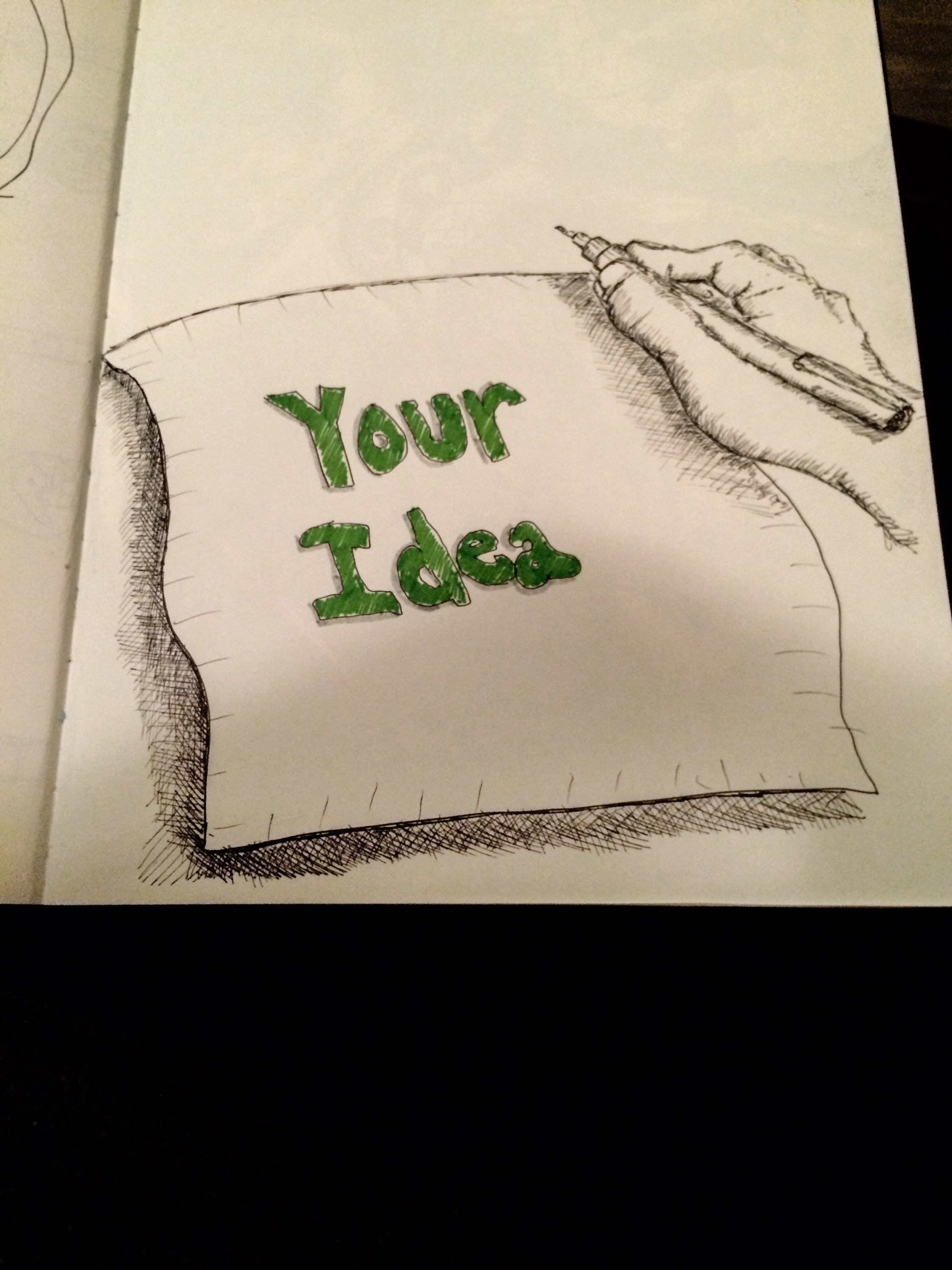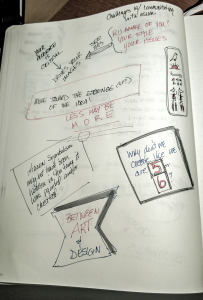This weekly challenge is actually for us! Our goal this week is to provide a better way you all can share your ideas, napkins, and creative journey. So we are listening, watching, and improving! In the meantime we would love to see your napkin work. Please post on our Facebook page or Twitter using #beerandnapkins! Have a creative week!
Category Archives: Sketchnote
Weekly Challenge November 17, 2014: Russell Tripp- Visual Literacy: Encoding vs. Decoding
Our challenge comes from Russell Tripp, CDO of Performance Posters, a design firm focusing on simplifying learning and development information .
Russell’s challenge follows our dialogue from last week of How we can convey Ideas through Art.
The challenge is that describing (and he purposely separated it as “DE”-“SCRIBING”) an image to someone who can’t see forces you to think of it in terms beyond just “What does it look like?” If you can describe what it says – and that can be anything from conveying the physical feeling of a texture to something as complex as an emotion or something as direct as an instruction – then you have understood it. It’s a way to practice and enhance your own visual decoding skills and, at the same time, learn ways of successfully encoding the same types of messages into your own visuals.
Challenge: De-scribe an image to someone who cannot see.
November 11, 2014 Meetup: How Can We Use Art to Convey Ideas
One of Beer and Napkin’s purposes is to provide learning opportunities to expand our understanding of “visual literacy.” At the November 11, 2014 Meetup Bridget Kirkland, Designer at Kirkland Designs and Instructor at USC Upstate and Designer Russell Tripp facilitated thought-provoking dialogue on How We can use Art to convey Ideas. Thanks to Russell for outlining some of the thoughts below from the session. Also, thanks to B&N advisor Paul Hebert for sharing his thoughts and sketchbook from the session.
The conversation started with Bridget sharing a number of personal visual and creative resources:
- Here is a list of Bridget’s book suggestions in case anyone missed them (Bridget, please correct/add if any are wrong or missing, thanks.):
- Ways of Seeing by John Berger
- The Creative Habit by Twyla Tharp
- Steal Like an Artist by Austin Kleon
- The Art Spirit by Robert Henri
- Drawing From Life: The Journal As Art by Jennifer New
In addition, Russell mentioned the book Drawing on the Right Side of the Brain by Betty Edwards. This is an excellent book for people who think they can’t draw. Anyone who can learn any other skill can learn to draw as well.
2. Set a regular schedule to practice, grab a journal and start sketching regularly
3. Be vulnerable and share your work with others. Learn from others on techniques, style, and general approach.
4. Act like you are 5! Bridget shared her experience being hypnotized by an artist into thinking she was actually 5 years old. She said the spirit in which she drew an image without inhibitions was the best ever!
5. There is no truly “universal” imagery or visual language beyond the most fundamental geometric shapes and primary colors (see Piet Mondrian). To create imagery that is readable (understood to mean the message you are trying to convey) to a particular audience, you must first understand that audience and their “lens”. That audience can be expanded by finding some, perhaps not immediately obvious, common ground within the diverse group you are trying to communicate with.
6. Understanding of your visual message can often be enhanced by simplifying the images used. Less unnecessary data means less chance of personal differences in interpretation.
7. Visual literacy incorporates a set of skills that can be trained just like any others, and which, combined with an analytic mindset, determine our level of visual literacy. Russell’s personal recommendation for improving visual literacy is to learn the fundamental elements and principles of design – there really aren’t that many – (http://goo.gl/1EcUK) and use that knowledge to analyze what you see and when you’re discussing it with other people. One way to have the opportunity to do both (and learn a surprising amount about human history and human nature) is to study art history (http://smarthistory.khanacademy.org/).
8. When creating a visual that we wish to convey a clear message, the onus is on us as the sender/creator of the message to be sure the visual message is understandable to the audience. Audience matters – design your visuals in terms of the recipient not the creator.
9. When developing any sort of visual message, sketch/try/work out lots of ideas before deciding on what to use. Get the obvious ideas out of the way first. You might come back to them, but give yourself options to choose from to find what’s right for your audience.
10. Remember that everyone projects their own emotions, experience, and understanding onto visual imagery when interpreting it. This can be valuable knowledge in designing specific visual messages when you understand your audience and simplify the design to allow this kind of projection.
Sample of Paul Hebert’s Sketchbook notes from the evening
Phil McCreight’s Sketchnotes
Weekly Challenge 10/13/14: Paul Hebert, Why do we fail?
Quote: “Why do we fall sir? So that we can learn to pick ourselves up.”- Alfred Pennyworth
Challenge: Everyone is going to fail sometime at something, the key is getting back into the saddle and continue to ride on! How do we we gain this resilience? First make connections, just as Bruce Wayne had Alfred Pennyworth in the Batman mythos, we need individuals and groups who can listen and give us those small words that hold us up and keep us going when the times get tough! You maybe already tough, but if you need a helping hand connect with a group or motivated individuals to help you build your dreams.
Napkin Doodle and Quote inspiration from Beer and Napkin Board of Advisor Paul Hebert
Paul is widely considered an expert on motivation and incentives and has been interviewed by the BBC, quoted in USATODAY, published in Loyalty360 magazine, published whitepapers and articles for HRM Magazine, is a contributing author on the Fistful of Talent blog, founding member of the editorial advisory team at HRExaminer.com, writes at his own company’s blog and is the Social Media Editor for the Enterprise Engagement Alliance.
Paul’s Digital Footprint:
- Symbolist Blog: http://www.symbolist.com/blog/
- LinkedIn: http://www.linkedin.com/in/paulhebert/
- Twitter: http://twitter.com/incentintel
- HRExaminer: http://www.hrexaminer.com/category/editorial-advisory-board/paul-hebert
- Fistful of Talent Blog: http://fistfuloftalent.com/author/paulhebert
- Enterprise Engagement Alliance:http://www.enterpriseengagement.org/







